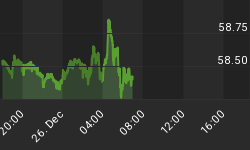The following is excerpted from a commentary originally posted at www.speculative-investor.com on 19th December 2013.
One characteristic of an investment bubble is dramatic upward price acceleration during the final 6-12 months of a long-term advance, followed by a price collapse. Beware, however, that it is possible for a price chart to create the impression of dramatic upward price acceleration even though nothing of the sort actually occurred. The reason is that a long-term advance at a steady annual percentage rate will look parabolic if plotted using a linear scale.
Let's take the example of gold. The following long-term chart creates the impression of dramatic upward acceleration into the 2011 price peak. It also creates the impression of a price collapse following the 2011 peak. But this impression is false, because it is solely due to the use of a linear scale for the Y-axis. With this linear scale, a 10% rise in the gold price from $1500 to $1650 looks five times bigger than a 10% rise in the gold price from $300 to $330. The rise is of course five times bigger in nominal dollar terms, but it is the percentage change that matters. Regardless of whether an investor buys gold at $1500 and sells at $1650 or buys gold at $300 and sells at $330, he achieves a 10% profit.

The above chart disguises the fact that the US$ gold price increased at a fairly consistent annual rate from 2001 through to 2011 and has since experienced a multi-year correction (as opposed to a collapse). The chart displayed below uses a log scale for the Y-axis and is a more accurate reflection of gold's long-term performance, the reason being that with the log scale a 10% rise or fall from one price will look the same as a 10% rise or fall from any other price.
Using the proper scaling technique we see that the gold price was extended to the upside at its 2011 peak, but no more extended than it was at the 2008 peak or the 2006 peak. In fact, the 250-day rate-of-change (ROC) included at the bottom of the chart suggests that gold was slightly less 'overbought' at its 2011 peak than at its 2006 peak. It was a lot more expensive at the 2011 peak than at earlier peaks, which is why the ensuing correction has been more substantial, but there is no evidence of the dramatic upward price acceleration typically seen during the final year of an investment bubble.

The next chart provides a clear contrast between gold's bubble-like performance leading up to its 1980 peak and gold's non-bubble-like performance leading up to its 2011 peak. The chart shows year-over-year percentage change.

While gold's price action hasn't provided evidence of a bubble at any time over the past 10 years, the same cannot be said about oil. The following log-scaled long-term chart reveals that oil's price action definitely displayed bubble-like attributes during 2007-2009. First, there was dramatic upward price acceleration during the final 12 months of a long-term advance, with the price more than doubling and moving well above the top of both the very long-term upward-sloping channel and the steeper/shorter-term upward-sloping channel on the log-scaled chart. (Note: In response to the price action and the extremely high level of the oil price relative to almost everything, we wrote in mid-2008 that in inflation-adjusted terms the oil price was probably making a secular peak.) Second, the 2008 price peak was followed by a spectacular collapse.

In conclusion, gold's price action leading up to its 1980 peak could reasonably be interpreted as evidence of an investment bubble, as could oil's price action leading up to its 2008 peak. However, to argue that gold's price action leading up to its 2011 peak was evidence of a bubble an analyst would have to make the basic mistake of ignoring percentage change.
We aren't offering a free trial subscription at this time, but free samples of our work (excerpts from our regular commentaries) can be viewed at: http://www.speculative-investor.com/new/freesamples.html















